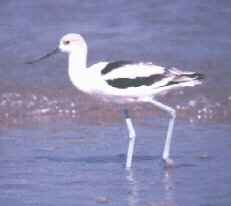American Avocet (Recurvirostra americana)

TPWD ©
- Description
- The American avocet is a long-legged shorebird. It is characterized by a long, thin bill that curves upward. In the female avocet, the bill curves up a little bit more. This shorebird has a distinctive black and white striped pattern on its back and sides. During the breeding season, the head and neck are a pinkish-tan and during the winter they are a grayish-white color. The avocet also has bluish-gray legs and feet; thus its colloquial name, "blue shanks."
- Life History
- The avocet feeds by thrusting its bill underwater and swinging it side to side along the bottom to stir up aquatic insects. It also will eat crustaceans and other aquatic animals and plant life that it happens to stir up or that it finds at the surface of the pond or marsh.
Avocets have elaborate courtship displays that include various actions and posturing. They nest in colonies of 10 to 12 from April to June constructing nests that are merely depressions on the sand or platforms of grass on mudflats. Should the water rise, the breeding pair will raise the nest up to a foot or more with sticks, weeds, bones and feathers to keep the eggs above water.
During the nesting period, avocets are aggressive toward intruders. They engage in distraction ploys one after another until they drive the interloper away. These displays include loud cries of displeasure, a "crippled bird" act, a "begging for pity" act and even a spectacular anti-predator "dive bomb" display where the bird will swoop down on the predator and narrowly miss it. The avocet pair incubates three to four olive-colored eggs for 22 to 24 days. The downy young not only feed themselves soon after hatching, but they can also swim. - Habitat
- American avocets commonly are found on mudflats, in saline lakes, in fresh water and saltwater marshes and on coastal bays.
- Distribution
- They may be found in migration from March to May, and again from July to October. Their nesting grounds are in the Great Basin region of the western United States. Locally, they breed in the Panhandle and in West Texas on the shores of inland playas and along the Gulf coast. American avocets winter as far south as Mexico and Guatemala.
- Other
- As a protected species under the Federal Migratory Bird Treaty Act, the only real threat to them is the loss of breeding and wintering grounds due to habitat degradation and destruction.